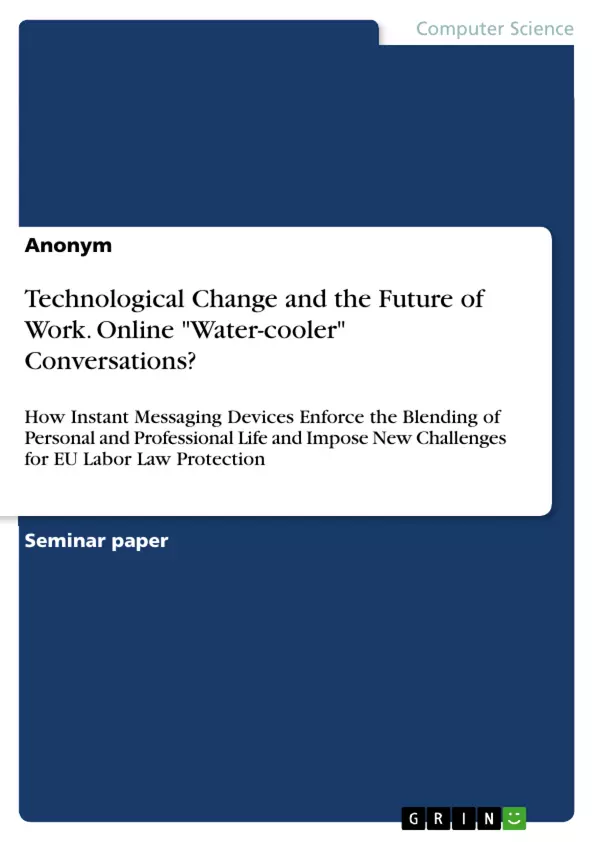The question, driving the following essay can be written down as follows? What makes IM (Instant Messaging) devices such as Slack different from earlier technologies such as e-mail and chat?
With increasing global connectivity, modern organizations face rapid organizational changes as for instance the increasing decentralized collaboration. IM is a communication technology that allows people to send and receive short text-based messages in real-time and to see who else is currently available. Many IM systems are available to be downloaded from the internet or come with other free software products. Commonly known examples are the ICQ Chat or the Facebook Messenger. Further, there are several IM systems that have been developed particularly for the professional use within organizations or other team-based work (Cameron & Webster, 2005). An exemplary IM device for the corporate use is Slack.
Slack is a ‘cloud-based digital workspace and information management system’ (Johnson, 2018, p. 148) that was published in 2013 and originally developed to manage productivity and improve team efficiency (Slack Technologies, 2020). It is a collaborative tool that facilitates streamlined communication. One of the main features is the broad accessibility that Slack offers: Users can access the platform via the web, a desktop plugin or even on a mobile application. Thus, Slack allows team members from different organizations as well as from different locations to join the collaborations and therefore enables real-time conversations. Those conversations, which can be direct and private as well as within group chats, are combined into one central location (the ‘workspace’) that keeps all messages archived. Within this workspace, channels dedicated to a specific group, project or topic are compromised. Furthermore, Slack integrates several external applications such as Google Drive or Dropbox to enhance any project-related management (Johnson, 2018).
Inhaltsverzeichnis (Table of Contents)
- Introduction
- PART I: Expected Impact of Instant Messaging Devices on Work
- Impact on Internal Communication
- Impact on Working Hours
- Impact of Instant Messaging Devices on Policy Implications
- PART II: Analysis and Discussion
- Importance of Law for Instant Messaging Devices
- Challenges for Labor Protection Imposed by Instant Messaging Devices
- PART III: Conclusion
Zielsetzung und Themenschwerpunkte (Objectives and Key Themes)
This assignment aims to investigate the potential impact of Instant Messaging (IM) devices, specifically Slack, on the blending of personal and professional life within the context of EU labor law. It examines the implications of IM devices on internal communication, working hours, and the challenges they pose for labor protection.
- Impact of IM devices on the blurring of boundaries between personal and professional life
- The role of IM devices in shaping communication dynamics within the workplace
- The potential impact of IM devices on working hours and employee availability
- Challenges for labor protection imposed by the widespread use of IM devices
- Policy implications arising from the increasing use of IM in the workplace
Zusammenfassung der Kapitel (Chapter Summaries)
The Introduction establishes the research question: Does the usage of IM at the workplace enforce the intertwining of the personal and professional life? The chapter then delves into the characteristics of IM devices, particularly Slack, and highlights their unique features compared to traditional communication technologies like email and chat.
PART I explores the expected impact of IM devices on work, drawing on the existing literature on flexibilization and the blurring of boundaries between work and private life. The impact on internal communication is discussed, highlighting the potential benefits of IM devices while also acknowledging the potential for disruptions and challenges.
PART II will delve into the analysis and discussion of the legal and labor protection implications of IM devices. This section will explore the importance of law in regulating the use of IM in the workplace and identify the specific challenges they pose for labor protection in the EU.
Schlüsselwörter (Keywords)
This assignment focuses on the following keywords: Instant Messaging (IM), Slack, Labor Law, EU, Communication, Working Hours, Flexibilization, Workplace, Privacy, Professional Life, Personal Life, Policy Implications, Labor Protection, Challenges.
- Arbeit zitieren
- Anonym (Autor:in), 2020, Technological Change and the Future of Work. Online "Water-cooler" Conversations?, München, GRIN Verlag, https://www.grin.com/document/945202



